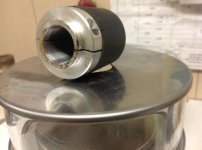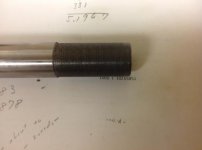Perhaps the different perspectives regarding this subject are rooted in application.
When I started coming up with a idea for a tuner, the goal was always that it had to work within the parameters of a 10.5 pound NBRSA rifle. This greatly reduced the options, as at that time, most of my Rifles were right on weight.
The first thing I did was figure out how light of practice barrel I could get out of a standard LV blank. By leaving only1inch of "straight" on the chamber end, I was able to get a 21 1/2 inch barrel down to 78 ounces. That gave me about 5 ounces to play with.
I decided on a one piece design, on a vey fine thread, (36 tpi), with considerable contact. I also decide to use two 6-32 pinch bolts to tighten the tuner onto the thread in order to achieve a firm lock, but still be easy to tune at the line.
After playing with just a aluminum tuner, I decided that some type of dampener could be incorporated. I wanted a hard rubber compound that I could press onto the tuner body. I ended up using a brass shell marine bearing. The final tuner weighed right at 5 ounces.
It was simple, easy to adjust, and it worked. I have now started using a different dampener, as I found a very hard rubber compound used on tug boat bumpers that I could machine and press onto the tuner body, with a flared end to secure it dimly.
Since this has been a number of years ago, most have forgot all of the "tuner wars" of the mid 2000's. Many designs were tried, people tended to look at match reports to ascertain the true affectivness of what ever design they wanted to try.
The main thing was unless you could make something that would attach to a LV or Sporter and still make weight, it all became a moot point. It also had to be easy to adjust, sitting at the Bench, under match conditions.
Through the years, what I have found is a tuner will not make a mediocre barrel shoot like a great barrel. What it will allow you to do is get every thing out of a given barrel, whether in be a Factory Barrel or a full house Krieger Custom.
Another thing that a tuner can do is allow you to fine tune the characteristics of the tune within the tuning window. One mistake many shooters make is thinking that a flat shooting rifle is in tune. They keep shooting .350 long "caterpillars" straight across the target, or 1" ones at 200. The tuner will allow you to tweak a small amount of verticle into the tune so the Rifle is so not darned wind sensitive.
This is especially helpful in score shooting. 30BR's can be a nightmare to shoot if you are caught in that "Horizonal tune", where you physically can't see the small changes that cause the bullets to go a lot further than they should. If I find my 30 is too wind sensitive to the left and right, I will tweak the tuner, get a little verticle in the Rifle, and go from there.
It works. Perhaps not so much in Group Shooting, because if the group forms just outside the moth ball, it's not as big of a deal, the skill of the shooter can overcome this, as you can always chase that first shot.
But in score, you have to hit that 10, or that X, every time.
Here is a picture of the inside of one of my tuners.
http://benchrest.com/attachment.php?attachmentid=15927&stc=1&d=1425300893




